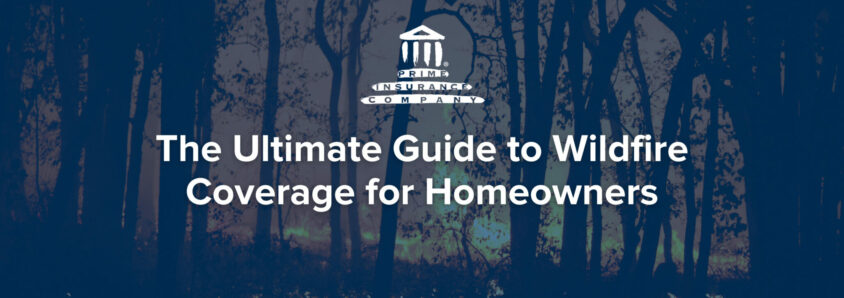The average number of acres burned by wildfires in the United States has been steadily increasing since the 1980s. In 1983, approximately 1.4 million acres of land were burned in wildfires. Jump forward to 2020 and that number had risen to more than 10.1 million acres.
For homeowners in many states, wildfires pose a serious threat. As an insurance producer, your clients likely know the value of having quality wildfire coverage as part of their homeowners insurance.
However, the reality is that many insurance companies aren’t providing this coverage under their homeowners insurance policies. The good news is that, here at Prime, we will write insurance for the excess and surplus line markets, including wildfire coverage.
In this blog post, we will highlight the risks posed by wildfires, the most commonly-affected states, and the benefits of offering wildfire coverage to your clients. Let’s get started.
What Are Wildfires?
A wildfire is defined as an uncontrolled fire that burns in wildland vegetation. They burn in areas such as prairies, grasslands, and forests.
Wildfires are often caused by human activities or as a result of natural phenomena (i.e. lightning). It is estimated that humans cause as much as 85% of all wildfires.
As noted in the introduction, wildfires are very common in the United States and cause a tremendous amount of damage, resulting in the loss of fire and damage to property and personal possessions. According to the National Interagency Fire Center, there have been an average of 70,000 wildfires in the United States every year since 1983.
California is the state most at risk from wildfires. The state leads the way in terms of the frequency of wildfires and the total number of areas burned. In 2021, more than 2 million properties in California were at risk from wildfires, with more than 9,000 wildfires occurring in total.
This was followed by Texas (717,000 properties at risk), Colorado (373,000) Arizona (242,000), Idaho (175,000), Washington (155,000), Oklahoma (153,000), Oregon (147,000), Montana (137,000), and Utah (136,000).
In terms of the states with the highest percentage of properties at risk, Montana lead the way in 2021 with 29%. This was followed by Idaho (26%), Colorado (17%), California (15%), New Mexico (15%), and Utah (14%).
In total, only two states/districts in the country did not experience any wildfires in 2021. These were Delaware and the District of Columbia.
Do All Homeowners Insurance Policies Cover Wildfires?
Did you know that 72% of homeowners don’t understand essential homeowners coverage? A Forbes survey of 2,000 homeowners found that most do not know how home insurance works even though many said they’re paying more for it than they were a year ago. With stats like these, insurance producers should talk with their clients about what is and isn’t covered on their policy.
As an insurance producer, it is likely that many of your clients assume that their standard homeowners’ insurance policy automatically covers wildlife. However, the reality is that this is not always true. As noted above, many insurance companies are not providing this coverage. Oftentimes, when it is covered, many companies are adding it with a large deductible.
For insurance producers looking to write more business and provide insurance solutions to their clients in need of non-standard homeowners insurance, their premier choice is Prime Insurance Company.
We understand that many homeowners require extra liability protection, for threats such as wildfires. Given that we are a leading excess and surplus lines insurance company, you can count on us to write non-standard homeowners insurance with confidence.
We have been doing this for more than 40 years and take a hands-on approach to learning about insurance producers, their clients, and their needs. This allows us to write a policy that ensures maximum protection.
What Should a Wildfire Policy Include?
As an insurance producer, there are a number of key elements that your wildfire insurance policy should cover to enable you to write more business and provide the best insurance solutions to your clients.
For example, a client’s policy should include the structure of their home and its contents. This is because wildfires have the ability to destroy a property’s structure, including the roof, walls, windows, doors, and flooring. Clients seeking non-standard homeowners insurance that includes wildfires will be seeking coverage that includes these. In terms of belongings, clients should seek to protect them by purchasing a minimum amount of content coverage through their wildfire policy.
Depending on the severity of the wildfire, clients may also need to live somewhere else for an extended period of time, such as in a hotel. This, naturally, can result in a large bill. Therefore, clients often seek to purchase additional living expenses coverage in order to limit their out-of-pocket costs.
Vandalism and theft coverage may also be included in a non-standard homeowners policy, given that there is a risk that a homeowner’s belongings will be stolen in the aftermath of a wildfire. A vandalism and theft policy may help to protect homeowners from criminal activity.
Another area where your client might seek coverage is in terms of landscaping. A homeowners insurance policy that includes landscaping coverage may protect a client from losses related to their gardens, etc.
Lastly, wildfire coverage should include coverage for a fire or even smoke damage claims that are from a wildfire. You can see large claims from smoke damage where there is no actual damage from fire to any of the structures.
We Understand the Need for Specialty Insurance
Wildfires are just one of the many reasons why your clients seek non-standard homeowners insurance. Other reasons include:
- They have a high-value home
- They live in an area with a high risk of floods, earthquakes, mudslides, etc.
- They have a vacant property
- They have a history of loss
- They have a home with a non-standard construction
Whatever the situation is, if your client can’t find the right homeowners insurance policy, let us see if we can help them.
Your Guide to Wildfire Coverage for Homeowners
Here at Prime Insurance Company, we help insurance producers looking to write more business for their clients. Our homeowners policies can include wildfire coverage, a major concern for homeowners across the country, especially in California.
If your client is not able to get proper coverage from the standard market, we are here to step in and fill the gaps, so as to provide the coverage they need.
To learn more or to get a quote, click here or contact us at 800-257-5590 or quotes@primeis.com.


